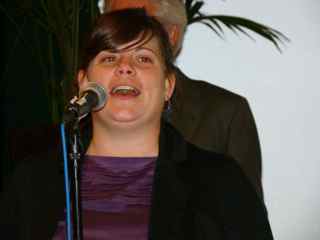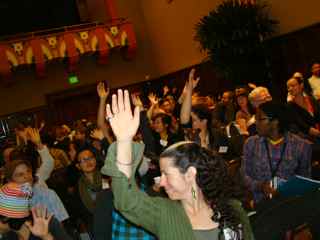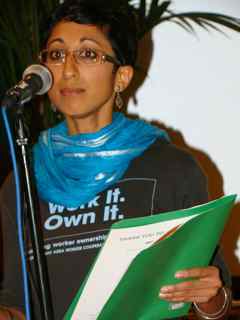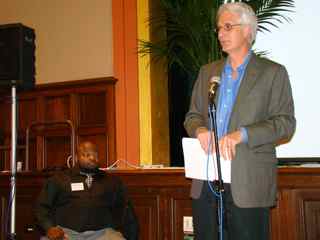At the opening gathering of the 4th bi-ennial conference of the U.S. Federation of Worker Cooperatives, it was clear that the movement has reached a significant milestone.


First, Executive Director Melissa Hoover announced that PBS (the Public Broadcasting Service) is "following the conference" (note that Twitter reference!) I believe because of the interest in the Evergreen Cooperatives.
Second, Melissa announced that 270(!) people were at the conference, the largest gathering ever in the USFWC history. The Federation is only six years old, having been born in Minneapolis in 2004. There was electric energy in the room when she made that announcement. She asked those present to raise their hands to indicate locality. Naturally the most of the worker cooperators were from the San Francisco Bay Area. The remaining were from Los Angeles, San Diego, Colorado, Oregon, New York, Massachusetts, DC, and other places in California, the U.S. and Canada.
What was loudly evident to me was that a hugely significant number of those faces in the crowd at the Krutch Theater had brown faces, dark hair, differently shaped eyes and many spoke a native language was not English -- the Latino, Asian and African attendance was also the highest ever. As one of the two or three person of color involved in organizing the conferences since the Federation's founding, this felt so absolutely good. It raised my excitement level.
Third, Melissa, our quick-on-her-feet, overworked and underpaid, creative nanny/"leader" (she won't like this but in many ways it's true), who fields the calls and the e-mails from across the U.S. and elsewhere, said in her opening remarks:
"There is a surge in the growth of cooperatives, not just in size (I think she mean numbers, but perhaps both), but in 'federating' " -- the coming together to cooperate with each other, pool resources, skills and ideas, as well as forming alliances with other activist organizations and even traditional institutions such as in the Evergreen cooperative model, an innovation conceived and spearheaded by the late John Logue at the Ohio Employee Owned Center as a way to revitalize Cleveland, Ohio a former industrial center.
"We're at an exciting time in the worker cooperative movement, Melissa said, explaining that the movement is building economic structures and making connections to other movements. "We're not just a business form."
Addressing the fact that cooperatives are often referred to as "alternatives" even in the progressive movement, Melissa said:
"I don't thank we're an alternative. I don't want to be an alternative. I want us to be the model..."
I missed the rest of the quote, but she said then said "I challenge you to think of ourselves" not as the alternative but the way.
Following Melissa, Shanta Sacharoff, a member of Other Avenues Food Store, which has 37 years of experience as a cooperative, said "our co-op was present when we gave birth to the organization (Federation)" in 2004. "It's still a work in progress."
Outlining conference history, Shanta said: "We took it to a higher level" in New York City, the site of the second conference. Responding in the spirit of cooperation, in 2008 the Federation met in hurricane-ravaged New Orleans to bring co-op skills and energy to help in the rebuilding efforts. It was that desire to provide models and to share skills, knowledge and resources that led to our first-ever cooperative showcase and a "work week" with New Orleans residents who were looking for ways to rebuild their lives.
"That was my favorite part," Shanta told the gathering.
David Karoly from the Network of Bay Area Worker Collectives, told the gathering that NoBAWC (pronounced "NO BOSS") members contribute $80 million in combined sales to the Bay Area economy and represent 1,000 workers. He also said that not all of the worker cooperatives in the area are members, so he estimates perhaps the overall financial impact is more like $100 million. NoBAWC was formed in 1994 and is the largest and oldest worker cooperative federation, he said.
Dave also pointed out that worker co-op development in the Bay Area was DIY -- Do It Yourself that led to spin-off cooperatives.


Sabiha Basrai, of Design Action, spoke next and her co-op was a case in point. A graphics/media co-op, they created themselves while working for Inkworks, a printing co-op.
"We used our own resources to start," she said. She also pointed out examples of intercoperation. "We hired Melissa from Brass Tacks," an accounting and administrative services co-op, to help with finances and "we buy pizaa from Arizmendi as much as possible," she said. Rainbow Grocery, the largest retail grocery co-op in the U.S., helped People's Food Co-op, in Portland, OR with technical assistance when they formed.
Bernard Marszalek, described himself as "releisured," instead of retired from a co-op. He is now working with the JAS-ECON -- Just Alternative Sustainable Economy. After outlining the growth of a festival of cooperatives that sprung from the idea of the Green Festivals, he said that "We hve to shrink the economy...we have to get rid of the oil economy and develop an economy that will sustain life."
Melissa then introduced Ted Howard, of the Democracy Collaborative from the University of Maryland, who helped to organize the Evergreen cooperatives. Howard had just left Atlanta and has been traveling around the U.S. talking about Evergreen.
"Throughout our country there is so much resignation and despair," he said as he faced the worker cooperative crowd. "It is heartwarming to be here in a place with so much energy."
Stay tuned for a separate post on Evergreen the Mondragon-inspired development model, and the economic development aspect of this project.

Add new comment